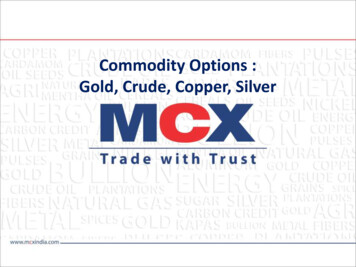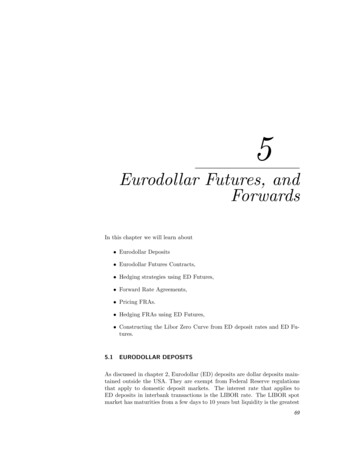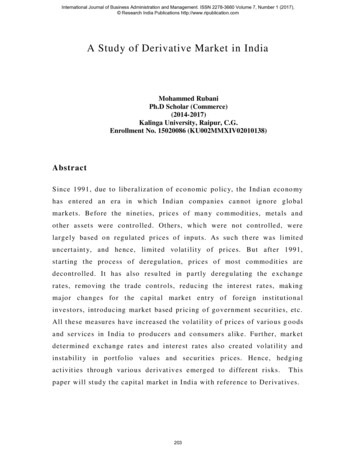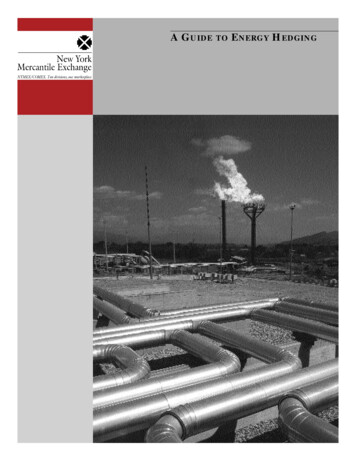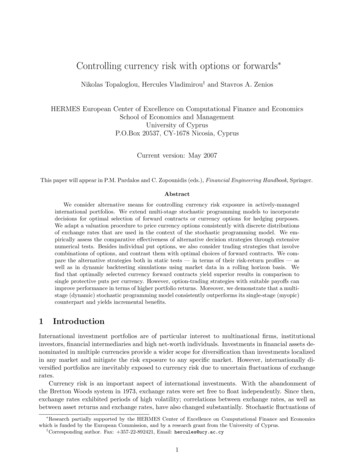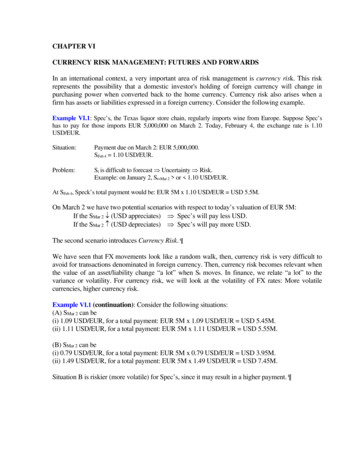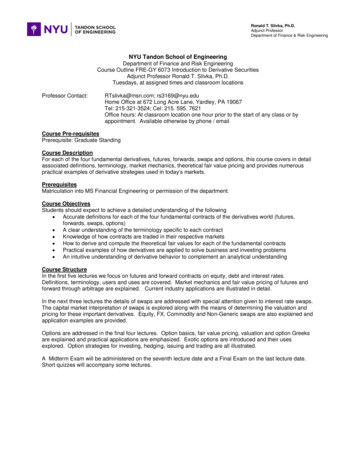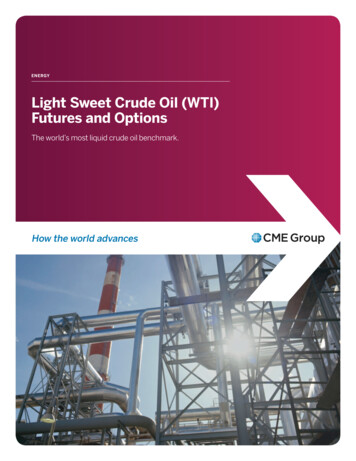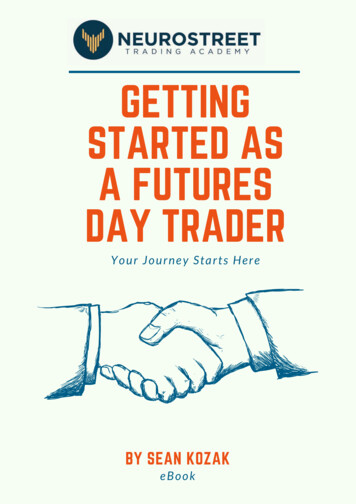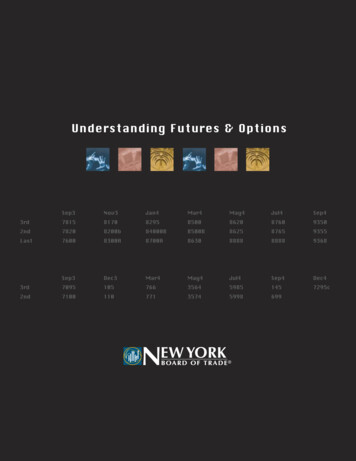
Transcription
Understanding Futures & OptionsUnderstanding Futures & 1077135745998699 1
This brochure – Understanding Futures and Options – offers an overview of the role andfunction of the modern exchange. It contains examples and descriptions designed to fosterbetter understanding of futures and options transactions. The examples and descriptionsare not intended to serve as investment advice and cannot be the basis for any claim. Whileevery effort has been made to ensure accuracy of the content, the New York Board of Tradedoes not guarantee its accuracy, or completeness or that any particular trading result canbe achieved. The New York Board of Trade cannot be held liable for errors or omissions inthe content of this brochure. Futures and options trading involves risk of loss and is notsuitable for everyone. Readers are advised that brokerage fees and commissions are notincluded in the examples and that margin levels are subject to change. Contact a broker forfee and commission information and current margin requirements. Trading on the NYBOTExchange markets is governed by specific rules and regulations set forth in exchange rules.These rules are subject to change. For more detailed information and specifications on anyof the products traded on the NYBOT exchanges, contact NYBOT or your broker.New York Board of Trade ‚ NYBOT , NYCE , FINEX , eCOPS ‚ TIPS , Coffee “C” , Cotton No. 2sm, Sugar No. 11sm, Sugar No. 14sm, U.S. Dollar Index , and USDX are registeredtrademarks/service marks of the Board of Trade of the City of New York, Inc. The NYSEComposite Index is a registered trademark of the New York Stock Exchange, Inc., which isnot a market for futures and options and not affiliated with NYBOT. Russell 1000 Index,Russell 2000 Index and Russell 3000 Index are trademarks/service marks of the RussellInvestment Group and are used under license. Reuters/CRBsm is a service markof Reuters.CC CT OJ SB SE K2
Understanding Futures & OptionsSince 1870, the futures and options markets of the New York Board of Trade (NYBOT ) haveprovided price discovery, risk management and price dissemination tools for industry users andongoing investment opportunities for market participants. By developing and supporting efficient andtransparent markets, the New York Board of Trade reaffirms on a daily basis the historic role of thetraditional futures and options exchange.The New York Board of Trade, Inc. was formed in 1998, as the parent company of the Coffee, Sugar& Cocoa Exchange, Inc. (CSCE) and the New York Cotton Exchange (NYCE ). Through the mergerof its two exchanges, NYBOT provides futures and options markets for a broad range of productsincluding cocoa, coffee, cotton, frozen concentrated orange juice (FCOJ), ethanol, sugar, currencycross-rates, the U.S. Dollar Index (USDX ), the Russell Indexes, the New York Stock Exchangesm(NYSE) Composite Index and the Reuters CRB Futures Price Index.While providing market users with reliable price discovery and price risk transfer functions throughtraditional open outcry trading in its global marketplace, the NYBOT offers price dissemination viathe internet through its real time market data service at www.nybotlive.com. Continuous exchangeand market information is also available through the NYBOT web site at www.nybot.com.In addition to its traditional price-related functions, the NYBOT develops and supports innovativeindustry-related services such as the electronic commodity operations and processing system(eCOPS ) – a web-based electronic delivery documentation platform that serves the coffee trade.C DX R MV EU XA.e COPS 3
Understanding Futures and OptionsThe Markets (Cash and manity’soldestcommercialactivi-ties. Nearly every community throughout history developed some sort of central mar-ketplace where people could meet and trade necessities such as foods, fibers and other basiccommodities. Over time, more participants entered the physical (cash) market. This lengthening ofthe marketing chain directly affected the value (price) of each commodity. Each participant in the chainadded value to the commodity (processed, transported, stored, refined, manufactured, etc.) and thisaffected the price. As participants added value, they acquired a stake in the price and thus a profitmargin to protect. Participants became more and more vulnerable to sudden price changes,thereby increasing instability and supply/demand speculation. A sudden change in the supply/demandequation can squeeze anyone in the chain needing to acquire a commodity that suddenly jumps in value orrequired to hold a commodity that decreases in value.As the markets for commodities like sugar, cocoa, cotton and coffee grew larger, the supply lines grewlonger.The TransAtlantic route (e.g. between London and New York) introduced another level of riskand merchants began writing individual contracts for expected deliveries (forward contracts) containingspecific terms of delivery (quantity, quality, anticipated date of delivery) all for a fixed price.With this increasing cash market risk, merchants for several basic commodities joined together in the latenineteenth century to establish a more organized and specialized marketplace for each commodity wherethey could meet and negotiate these forward contracts. The forward contract, however, was still a cashmarket instrument whereby a price was negotiated for an actual physical commodity transaction at afuture date of delivery. The contract applied to the unique terms of one transaction, but the existenceof this piece of paper added another possible level of trade – the idea of buying and selling the contractitself. As a binding instrument that committed the holders to a transfer of the physical commodity, thecontract itself could change hands many times as long as its terms remained outstanding (until the actualdelivery took place).As the buying and selling of an existing contract became an accepted practice, the standardization of that contract became the next logical step. The standardization of the forwardcontract led to the creation of the futures contract that added a whole new dimension to commoditytrading. The cash market continued its day-to-day business of selling and buying a commodity atthat day’s price.4
The organization of merchants buying and selling the physical commodity evolved into anorganization that standardized the contracts and the trading practices, and became the futures exchange.The acceptance of the standard contract allowed organized trading of the value of thecommodity for delivery at some future date through a futures market for the commodity.The futures contract had specific terms, amount, type, price, timeframe, etc., but unlike theforward contract, it did not apply to any specific transaction. A “standard” contract with standard termsthat applied across the board was developed. The terms applied to the commodity being priced and therefore gave validity to the price. The commodity could change hands under the terms of the contract, butthat was not its purpose – its purpose was to establish a price for the commodity for a defined periodof time (the term of the contract). This price became a benchmark for determining the day-to-day cashmarket price. It also established the futures contract as an instrument that had its own value and couldbe traded apart from the physical commodity. The standardization of the contract and trading practiceseven removed the need to trade actual pieces of paper. No longer was a paper contract necessary, only anenforceable record of the transaction and payment.The ExchangeHistorically, the futures and options exchange has been a membership organization that provides and operates the facilities for trading; establishes, monitors and enforces rules for trading;and keeps and disseminates trading data. By establishing a visible, free market setting where theforces of supply and demand can come together for the trading of futures and options, theexchange can fulfill its pricing functions – price discovery (the negotiation of the current bestprice); price risk transfer (the shifting of cash market price risk exposure to other hedgers withopposite risk profiles or to other futures market participants who are willing to assume risk in return for aprofit opportunity); and price information (the regular and timely dissemination of pricing information toall interested parties around the world).
The PriceThe current price of the “nearby” futures contract (the contract with the closest expiration date)represents a benchmark for the cash market price. The worldwide dissemination of the futures priceinformation contributes to wider market participation, which reflects the conditions of the cashmarket as a whole more effectively.More buyers and sellers in the marketplace mean betterpricing opportunities (more competition for price), thereby increasing the quality of the pricediscovery process.The exchange ensures the integrity of the trading process through itsclearly defined and monitored rules that include an arbitration process to resolve trading disputes.The difference between the specific futures contract price and the cash price for the commodity at thelocal delivery point is called the “basis.” Normally, the futures price (in the case of a physical commodity)should be equal to the present cash price plus the amount of storage, insurance, etc. (carrying charges)necessary to carry the commodity to the delivery month of the contract. In addition, basis pricing can alsoreflect the location (port of delivery) and the quality of the commodity. For example, a particular growthof coffee from a specific country might trade at a negotiated premium or discount to the futures ference,thecommoditypricingsystem works well because they tend to parallel each other over time. As the contract delivery dateapproaches, the nearby futures price and the cash price move closer together (convergence). Whilefutures and options do have a strong parallel relationship, the basis figure is not constant. Thebasis tends to widen or narrow depending on such key factors as supply and demand at thelocal delivery point.The existence of price risk in the cash market makes futures and optionsmarkets necessary.Price DisseminationAs one of the three basic functions of an exchange (the others being price discovery and price risktransfer), price dissemination is a critical responsibility. Market participants need access to “real-time”data in order to effectively trade markets. Such data feeds have historically been available throughthird-party vendors who package market data from various exchanges and deliver it to subscribers overtheir own proprietary systems. With the evolution of the Internet, NYBOT now offers direct access toits market data over the world wide web via NYBOTLive. Market participants can subscribe equired.Thesubscriberalsohasaccess to important trading tools (historical data, charts and graphs) to help interpret the data.6
Understanding Futures & OptionsPrice risk is measured in terms of price volatility (the magnitude of price movement in either direction).volatilityGreater volatility means greater risk for everyone in the marketing gesmeasurepricePricevolatili-ty for a specific commodity to determine its suitability for futures/options trading. Futures andoptions markets do not create or remove volatility and risk; the volatility and risk originate in theunderlying cash market.participants.That same volatility creates trading opportunities for all marketFutures and options markets provide risk management tools to help reduce theprice risk exposure that comes from price volatility.30-Day Historical Volatility120%100%80%60%40%20%Jan9Ju 4l-9Ja 4n9Ju 5l-9Ja 5n9Ju 6l-9Ja 6n9Ju 7l-9Ja 7n9Ju 8l-9Ja 8n9Ju 9l-9Ja 9n0Ju 0l-0Ja 0n0Ju 1l-0Ja 1n0Ju 2l-020%COFFEECOCOASUGAR7
The Contract The futures contract is a standardizedlegal commitment to deliver (or receive) a specific quantity of a commodity with specific quality/characteristics(or its cash equivalent) on a specified date at a specified delivery point. Cash market participants negotiate the buying and selling (the transfer of title) of a specific product; futures market participants focus on the buying and selling of a contract on the underlying prod uct. With the contract standardized in terms of delivery months and locations, quantity and grade of the commodity, the onlyelement left to negotiate in the exchange market is the price. In essence,traders of futures are buying and selling in an open marketplace a price for the underlying commodity. Since price and not the commodityis the focus of the futures and options market, delivery of the actual commodity is a function that generally is assigned to the cash market.The mar- ket makes it easy to enter and exit the marketbefore delivery becomes even a possibility. All the mechanisms of the futuresmarketplace focus on the taking of a “price” position and then closing it out at a profit or loss. Although only a small percentage of contracts actually come to delivery, the NYBOT exchanges have pro grams and procedures that guide the delivery process. For coffee and cocoa deliveries at the New YorkBoard of Trade, the process has historically been managed electronically by the Commodity Operations and Processing System (COPS ). Based upon this pioneeringsystem, the NYBOT has developed eCOPS – an Internet-based system designed to serve both the futures and cash delivery process through electronic documentation and standardized procedures. T h e M a r k e t p l a c e The futures market serves buyersand sellers equally; they may enter the market on either the buy or the sell side. New buyers of futures contracts establish a “long” position and new sellers of futures establish a “short” position. Most positions are closed out by completing an equal transaction on the opposite sideof the original position: long positions are closed out by selling and short positions by buying. Physicaldelivery or cash settlement can alsosatisfyis carried to contract expiration. the obligation if the position 8
Understanding Futures & OptionsT h e Tr a d e r sFutures exchanges serve essentially two types of traders – hedgers who seek to transfer their cash marketprice risk to other futures market participants and investors/speculators who are willing to assume thatrisk in exchange for the opportunity to profit from price movement in the futures market. The hedger enters the futures market to transfer/reduce risk associated with cash market transactions. The hedger maybe protecting a cash market buy or sell price; they are representatives of different levels of the actual trade(grower, merchant, manufacturer, etc.) who are subject to cash market price risk. Hedging involves establishing a position in the futures market equal to and opposite a position in the cash market.Hedging is not about taking risk. Hedging is the opposite of speculating. An effective hedging strategyreduces risk exposure. A gain in the futures market will offset a loss in the cash market, or vice versa. Agrower who harvests coffee, for example, has coffee to sell. Therefore, the grower is said to be a natural“long” in physical/cash coffee. To hedge the crop, the grower could protect the selling price of the cashmarket coffee by establishing the opposite or “short” position in the futures market (sell futures contracts).Other hedgers, such as a coffee roaster, may need coffee (are “short” physical coffee) and therefore seek toprotect the buy price of cash market coffee. The roaster could take a long position in the futures market(buy futures) to place a hedge.Investors, on the other hand, are willing to assume the price risk by taking a position on either side of the market in order to pursue a profit from changing prices. Futures investors seek onlyto buy low and sell high and vice versa. The unimportance of chronology in buying low and selling high illustrates a unique element of the futures market – the availability of opportunity in a rising or declining market.Market participants can enter the market on either side (long or short).Access, risk level and opportunity over the long term are basically similar on both the long andshort sides of the market.The presence of different participants in the marketplace – hedg-ers with opposing risk profiles, investors with different short or long-term strategies and goals –creates ongoing trading opportunities on both sides. The participation of investors with a widevariety of goals and strategies contributes important liquidity to the market, increases pricediscovery efficiency, and facilitates the hedging process.Types of investors may range from a“local trader” who seeks gains from small price movements within a short time frame (often holding a position for less than a day) all the way to large commodity funds that may establish a strategic position for alonger term until a specific price goal is reached.9
Price volatility broadens the spectrum of opportunities for all market participants. The fact that prices canswing in either direction quickly and substantially can benefit both hedgers and investors. The same pricevolatility that makes futures and options markets effective tools for hedgers creates opportunities for investors. It should be understood, however, that price volatility in a commodity is inherent to the cash market,not the result of speculation in the futures market. Without volatility no reason exists for a futures market,because price risk is minimal. The need to transfer risk is a primary engine for the futures market.T h e Tr a n s a c t i o nFutures trades begin with one basic step: buyers and sellers deposit funds – called margin – as a performance bond or good faith deposit with a brokerage firm to ensure that market participants will meettheir contractual obligations. The margin commitment is the same for both buyers and sellers. There isoften a difference, however, between the margins required of hedgers and the commitments for speculators. This system of initial (or original) margin deposits (usually a small percentage of the total valueof the underlying contract) helps to maintain the financial integrity of the futures market and 20300700500210150Agricultural(In U.S. Dollars)SUGAR #11SUGAR # 14COCOACOFFEEMINI COFFEECOTTONIntra CropStraddle*Inter CropStraddle*FCOJ560400participants with the leverage that is a major feature of futures trading. Since a futures contract is notintended for use as a merchandising contract for transfer of title from seller to buyer, there is no need forthe full contract value to change hands.An illustration:On September 10, 2003, the initial margin for a hedger in the Cotton No. 2Contract was 1,000 on a contract valued on that day at 30,350 (price 60.70 cents/lb.).smTheinitial margin for a speculator was 1,400 per contract. Even for the speculator that represents less than 5%of the total value of the contract.10
Understanding Futures & OptionsThe New York Clearing Corporation (NYCC) – the clearinghouse for all trades in the NYBOT markets– guarantees contract performance to its members by establishing, with the exchange, minimum marginlevels for each market and periodically adjusting them to reflect current price volatility. The clearinghouseis made up primarily of brokerage firms who serve as clearing members and must meet certain financialrequirements and responsibilities including a guaranty deposit at the clearinghouse.The NYCC serves as counterparty to every trade and guarantees the integrity of each contractin the NYBOT markets.The clearinghouse also oversees the transfer of money among mem-bers. At the close of each trading day, each trader’s account equity is adjusted (marked to the market) to reflect price movements.If the market has moved against the trader’s position, variationmargin payments may be required to restore the trader’s equity to the required minimum level.In the traditional exchange, the actual transaction takes place in designated trading rings (pits) wheremembers meet to make bids and offers to each other by voice and hand signals (open outcry). Tradesare acknowledged by the participants and confirmed in writing or through an electronic order routingsystem (EOR). Since only exchange members can trade on the floor, customer orders are delivered to floorbrokers who execute them according to the customer’s instructions. Among the common orders that arefilled in the pit are market orders (executed immediately at the prevailing price in the pit); limit orders(to be executed at the stated price or better); and stop orders (instructs broker to execute an order at themarket if a certain price is reached).Once the transaction has taken place, it is entered manually or electronically into NYBOT’s Trade InputProcessing System (TIPS ) where it is matched, and assigned to a clearing member. Only clearing members can submit trades for clearing. When the trade is matched and submitted, the clearinghouse thenbecomes the buyer to every seller and seller to every buyer.From the moment the order enters the market, its path is marked clearly in terms of time stamps that recordits progress. This path is called an audit trail that helps to protect the interests of all parties involved in thetrade. The audit trail is one of the key tools of regulation that govern the futures market and protect theintegrity of each trade.11
RegulationHedgingThe exchange subsidiaries and divisions of theDifferent markets utilize different hedging strate-New York Board of Trade write, administer andgies, which may change throughout the year de-enforce their own rules, utilizing their surveillancepending on cash market situations and businessand compliance systems and staff.goals. The basic elements of hedging are constant.Establishing a futures hedge locks in a price for theThe Commodity Futures Trading Commissionbuyer or the seller. The hedger will still be subject(CFTC) is the federal regulatory agency respon-to basis risk and the strengthening or weakeningsible for the oversight of all futures markets inof the hedger’s basis (difference between the cashthe U.S. The National Futures Association (NFA)and futures price) will affect the net result of theis a self-regulatory organization registered withhedge.the CFTC. It promotes ethical standards, enforcescustomer protection rules and screens profes-An effective hedging strategy requires a workingsionals for membership in the NFA. Registra-knowledge of how futures markets function com-tion with the CFTC is required for floor tradersbined with a specific marketing plan that accurately– including floor brokers (exchange members whocomputes and interprets cash market costs and pro-handle customer orders on the trading floor) andjected profit margins. A number of tools exist with-locals (exchange members who trade for theirin and around the futures market that can help bothown account), futures commission merchantshedgers and investors. Along with a marketing plan,(FCMs), introducing brokers (IBs) and theirhedgers must be able to fundamentally analyzeassociatedpersons(APs)whohandlecustomer funds. The registration requirement forcommoditytradingadvisors(CTAs) and commodity pool operators (CPOs) depends on theamount of money they control incustomer funds and the numberof participants in the pool.12their market – to know the physical factors that affect price and how to interpret these signals.
Understanding Futures & OptionsA frost threat in Florida, for example, can obviously play a role in the pricing of FCOJ.This fundamental analysis is an important part of a basic hedging program. Investors also need knowledge of these factors.Investors (and to some degree hedgers) also have come to rely on a variety of mathematical tools that allow technical analysis of the markets over time. Technical tools utilize charting programs that track andinterpret historical patterns (e.g., moving averages), which can assist a trader in developing a strategic plan.The NYBOTLive market data service provides a charting package with an array of technical tools to assisttraders. The importance of quality market information, thorough analysis of that information, strategicplanning and disciplined execution cannot be overemphasized for both hedgers and investors.The NYBOT web site at www.nybot.com provides a Research Reports section that offers market userscomplimentary access to market analysis and commentary by prominent analysts and other industry professionals. Such reports can be an excellent source of specific market information and opinions on both thefundamental and technical levels.Tr a d i n g E x a m p l e sFor purposes of simplicity, the following examples do not include the commission costs thatbuyers and sellers may incur in futures and options trading.The commission costs, which varyfrom one brokerage firm to another, also include exchange/clearing fees.Although the broker-age and exchange fees for futures and options trading are relatively modest, these costs must befactored into any hedging or investment program to provide an accurate picture of the net profit or loss.Ask a broker for current commission rates and exchange fees.Such costs are usuallycalculated on a per-contract-traded basis and often quoted in terms of a “round turn” – meaningupon the closing out of each contract position. The first two hedging examples do notinclude the basis figure, which will vary over time. A full understanding of historical basis is a necessarycomponent of any risk management plan. Consult a broker to learn more about calculating and interpreting basis. All of the hypothetical examples in this brochure are for illustration purposes only. They do notconstitute trading advice.13
Tr a d i n g F u t u r e sFutures markets serve the objectives of both hedgers and investors. Hedgers use the futuresmarket to protect cash market transactions and thereby reduce the effect of price volatility in the cashmarket on their bottom line. Hedgers assume a position in the futures market roughly equal to andopposite the cash market position they wish to hedge. Investors, on the other hand, may enter the marketon either side depending on their individual strategy. Regardless of the market direction, they seek toanticipate and profit from the price changes that may occur over the short or long term. It is important tounderstand the basic difference in the business goals of hedgers and investors when examining the tradingscenarios that follow.A Sugar Long Futures Hedge ExampleCommercial firms use the futures market to protect cash market commitments that arise in their day-to-dayoperations.SCENARIO:A candy manufacturer has profit margins that are extremely sensitive to the cost of sugar.InAugust, he/she contracts to sell candy for delivery in November at a fixed price. Themanufacturer will need 224,000 pounds of raw sugar (equal to 2 Sugar No. 11sm futures contracts of 112,000pounds each) to make the candy. In order to maximize profits, the candy maker needs to buy sugar forOctober delivery at a price of
Understanding Futures & Options Since 1870, the futures and options markets of the New York Board of Trade (NYBOT) have provided price discovery, risk management and price dissemination tools for industry users and ongoing investment opportunities for market participants. By developing and supporting efficient and

